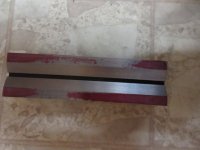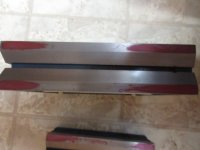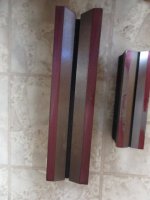rhb
Aluminum
- Joined
- Apr 27, 2019
- Location
- A small town in central Arkansas
I just received a pair of Chinese 0.0002"/10" levels, a 6" and a 6" x 6" which I thought might be of interest here.
I put some Canode on a grade B surface plate and spread it with a soft rubber printer's brayer. You can see the results in the photos. It was immediately obvious that the vertical side of the square was very flat from the resistance when I slid it across the surface plate.
I don't have a proper reference to test the squareness, so I'll leave the horizontal face alone until I do.
I've not checked either by reversal yet, but adjusting a level is not a big deal. The square came with an adjusting wrench.
I should note that I was given some 0.0002"/10" bare vials. While I was setting one up to sense electronically I bumped the teet on the end. After the fluid evaporated I could see that the vial was not uniformly ground over the entire length. It's very difficult to see and impossible to photograph. You get what you pay for. However, as I typically place the level on the carriage when I'm leveling a lathe the lack of flatness really doesn't matter. When I checked my Clausing 4902 yesterday with my 8" 0.0005"/10" level it became apparent that the floor of my shop had tilted a few thou in the last 3-4 years. That side of the shop is on about 5-6' of fill, so that's not at all surprising. I did observe a 0.0005" twist between the extremes of travel which I'll correct later today. To center the bubble I'll just put a feeler gauge blade under one end.
Have Fun!
Reg
I put some Canode on a grade B surface plate and spread it with a soft rubber printer's brayer. You can see the results in the photos. It was immediately obvious that the vertical side of the square was very flat from the resistance when I slid it across the surface plate.
I don't have a proper reference to test the squareness, so I'll leave the horizontal face alone until I do.
I've not checked either by reversal yet, but adjusting a level is not a big deal. The square came with an adjusting wrench.
I should note that I was given some 0.0002"/10" bare vials. While I was setting one up to sense electronically I bumped the teet on the end. After the fluid evaporated I could see that the vial was not uniformly ground over the entire length. It's very difficult to see and impossible to photograph. You get what you pay for. However, as I typically place the level on the carriage when I'm leveling a lathe the lack of flatness really doesn't matter. When I checked my Clausing 4902 yesterday with my 8" 0.0005"/10" level it became apparent that the floor of my shop had tilted a few thou in the last 3-4 years. That side of the shop is on about 5-6' of fill, so that's not at all surprising. I did observe a 0.0005" twist between the extremes of travel which I'll correct later today. To center the bubble I'll just put a feeler gauge blade under one end.
Have Fun!
Reg




